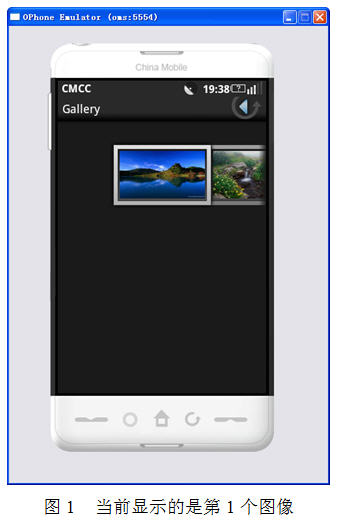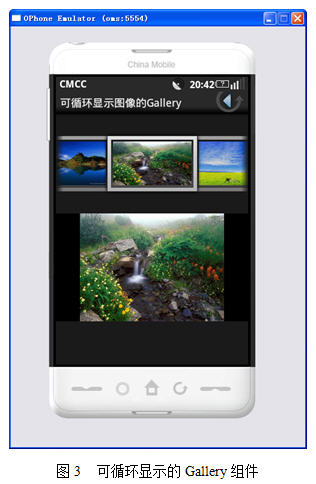gallery ,imageSwitcher 结合使用
2011-05-19 16:03
423 查看
Gallery组件的传统用法
Gallery组件可以横向显示一个图像列表,当单击当前图像的后一个图像时,这个图像列表会向左移动一格,当单击当前图像的前一个图像时,这个图像列表会向右移动一样。也可以通过拖动的方式来向左和向右移动图像列表。


从图2可以看出,当显示到最后一个图像时,列表后面就没有图像的,这也是Gallery组件的基本显示效果。在本文后面的部分将详细介绍如何使Gallery组件显示到最后一个图像时会从第1个图像开始显示。
好了,现在我们来看一下图1和图2的效果是如何做出来的吧。Gallery既然用于显示图像,那第1步就必须要有一些图像文件用来显示。现在可以随意准备一些图像。在本文的例子中准备了15个jpg文件(item1.jpg至item15.jpg)。将这些文件都放在res/drawable目录中。
下面将这些图像的资源ID都保存在int数组中,代码如下:
private int[] resIds = new int[]
{ R.drawable.item1, R.drawable.item2, R.drawable.item3,
R.drawable.item4, R.drawable.item5, R.drawable.item6,
R.drawable.item7, R.drawable.item8, R.drawable.item9,
R.drawable.item10, R.drawable.item11, R.drawable.item12,
R.drawable.item13, R.drawable.item14, R.drawable.item15 };
在本例的main.xml文件中配置了一个Gallery组件,代码如下:
<?xml version="1.0" encoding="utf-8"?>
<LinearLayout xmlns:android="http://schemas.android.com/apk/res/android"
android:orientation="vertical" android:layout_width="fill_parent"
android:layout_height="fill_parent">
<Gallery android:id="@+id/gallery" android:layout_width="fill_parent"
android:layout_height="wrap_content" android:layout_marginTop="30dp" />
</LinearLayout>
现在在onCreate方法中装载这个组件,代码如下:
public void onCreate(Bundle savedInstanceState)
{
super.onCreate(savedInstanceState);
setContentView(R.layout.main);
// 装载Gallery组件
Gallery gallery = (Gallery) findViewById(R.id.gallery);
// 创建用于描述图像数据的ImageAdapter对象
ImageAdapter imageAdapter = new ImageAdapter(this);
// 设置Gallery组件的Adapter对象
gallery.setAdapter(imageAdapter);
}
在上面的代码中涉及到一个非常重要的类:ImageAdapter。该类是android.widget.BaseAdapter的子类,用于描述图像信息。下面先看一下这个类的完整代码。
public class ImageAdapter extends BaseAdapter
{
int mGalleryItemBackground;
private Context mContext;
public ImageAdapter(Context context)
{
mContext = context;
// 获得Gallery组件的属性
TypedArray typedArray = obtainStyledAttributes(R.styleable.Gallery);
mGalleryItemBackground = typedArray.getResourceId(
R.styleable.Gallery_android_galleryItemBackground, 0);
}
// 返回图像总数
public int getCount()
{
return resIds.length;
}
public Object getItem(int position)
{
return position;
}
public long getItemId(int position)
{
return position;
}
// 返回具体位置的ImageView对象
public View getView(int position, View convertView, ViewGroup parent)
{
ImageView imageView = new ImageView(mContext);
// 设置当前图像的图像(position为当前图像列表的位置)
imageView.setImageResource(resIds[position]);
imageView.setScaleType(ImageView.ScaleType.FIT_XY);
imageView.setLayoutParams(new Gallery.LayoutParams(163, 106));
// 设置Gallery组件的背景风格
imageView.setBackgroundResource(mGalleryItemBackground);
return imageView;
}
}
在编写ImageAdapter类时应注意的两点:
1.
在ImageAdapter类的构造方法中获得了Gallery组件的属性信息。这些信息被定义在res/values/attrs.xml文件中,代码如下:
<?xml version="1.0" encoding="utf-8"?>
<resources>
<declare-styleable name="Gallery">
<attr name="android:galleryItemBackground" />
</declare-styleable>
</resources>
上面的属性信息用于设置Gallery的背景风格。
2.
在ImageAdapter类中有两个非常重要的方法:getCount和getView。其中getCount方法用于返回图像总数,要注意的是,这个总数不能大于图像的实际数(可以小于图像的实际数),否则会抛出越界异常。当Gallery组件要显示某一个图像时,就会调用getView方法,并将当前的图像索引(position参数)传入该方法。一般getView方法用于返回每一个显示图像的组件(ImageView对象)。从这一点可以看出,Gallery组件是即时显示图像的,而不是一下将所有的图像都显示出来。在getView方法中除了创建了ImageView对象,还用从resIds数组中获得了相应的图像资源ID来设置在ImageView中显示的图像。最后还设置了Gallery组件的背景显示风格。
OK,现在来运行这个程序,来回拖动图像列表,就会看到如图1和图2所示的效果了。
循环显示图像的原理
循环显示有些类似于循环链表,最后一个结点的下一个结点又是第1个结点。循环显示图像也可以模拟这一点。
也许细心的读者从上一节实现的ImageAdapter类中会发现些什么。对!就是getView方法中的position参数和getCount方法的关系。position参数的值是不可能超过getCount方法返回的值的,也就是说,position参数值的范围是0至getCount()
- 1。
如果这时Gallery组件正好显示到最后一个图像,position参数值正好为getCount()
- 1。那么我们如何再让Gallery显示下一个图像呢?也就是说让position参数值再增1,对!将getCount()方法的返回值也增1。
那么这里还有一个问题,如果position参数值无限地增加,就意味着resIds数组要不断地增大,这样会大大消耗系统的资源。想到这,就需要解决两个问题:既要position不断地增加,又让resIds数组中保存的图像资源ID是有限的,该怎么做呢?对于getCount()方法非常好解决,可以让getCount方法返回一个很大的数,例如,Integer.MAX_VALUE。这时position参数值就可以随着Gallery组件的图像不断向前移动而增大。现在resIds数组只有15个元素,如果position的值超过数组边界,要想继续循环取得数组中的元素(也就是说,当position的值是15时,取resIds数组的第0个元素,是16时取第1个元素),最简单的方法就是取余,代码如下:
resIds[position % resIds.length]
在本节对ImageAdapter类做了如下两个改进:
1.
使getCount方法返回一个很大的值。建议返回Integer.MAX_VALUE。
2.
在getView方法中通过取余来循环取得resIds数组中的图像资源ID。
通过上面两点改进,可以使图像列表在向右移动时会循环显示图像。当然,这种方法从本质上说只是伪循环,也就是说,如果真把图像移动到getCount方法返回的值那里,那也就显示到最后一个图像的。不过在这里getCount方法返回的是Integer.MAX_VALUE,这个值超过了20亿,除非有人真想把图像移动到第20亿的位置,否则Gallery组件看着就是一个循环显示图像的组件。
实现循环显示图像的Gallery组件
在本节将组出与循环显示图像相关的ImageAdapter类的完整代码。读者可以从中看到上一节介绍的两点改进。为了使界面看上去更丰满,本例还在单击某一个Gallery组件中的图像时在下方显示一个放大的图像(使用ImageSwitcher组件)。本例的显示效果如图3所示。当不断向后移动图像时,图像可不断显示,读者可以自己运行本例来体验一下。

在main.xml文件中定义的Gallery和ImageSwitcher组件的代码如下:
<?xml version="1.0" encoding="utf-8"?>
<LinearLayout xmlns:android="http://schemas.android.com/apk/res/android"
android:orientation="vertical" android:layout_width="fill_parent"
android:layout_height="fill_parent">
<Gallery android:id="@+id/gallery" android:layout_width="fill_parent"
android:layout_height="wrap_content" android:layout_marginTop="30dp" />
<ImageSwitcher android:id="@+id/imageswitcher"
android:layout_width="fill_parent" android:layout_height="wrap_content"
android:layout_marginTop="30dp" />
</LinearLayout>
本例中Main类的完整代码如下:
package net.blogjava.mobile;
import android.app.Activity;
import android.content.Context;
import android.content.res.TypedArray;
import android.os.Bundle;
import android.view.View;
import android.view.ViewGroup;
import android.view.animation.AnimationUtils;
import android.widget.AdapterView;
import android.widget.BaseAdapter;
import android.widget.Gallery;
import android.widget.ImageSwitcher;
import android.widget.ImageView;
import android.widget.AdapterView.OnItemSelectedListener;
import android.widget.Gallery.LayoutParams;
import android.widget.ViewSwitcher.ViewFactory;
public class Main extends Activity implements OnItemSelectedListener,
ViewFactory
{
private Gallery gallery;
private ImageSwitcher imageSwitcher;
private ImageAdapter imageAdapter;
private int[] resIds = new int[]
{ R.drawable.item1, R.drawable.item2, R.drawable.item3, R.drawable.item4,
R.drawable.item5, R.drawable.item6, R.drawable.item7,
R.drawable.item8, R.drawable.item9, R.drawable.item10,
R.drawable.item11, R.drawable.item12, R.drawable.item13,
R.drawable.item14, R.drawable.item15 };
public class ImageAdapter extends BaseAdapter
{
int mGalleryItemBackground;
private Context mContext;
public ImageAdapter(Context context)
{
mContext = context;
TypedArray typedArray = obtainStyledAttributes(R.styleable.Gallery);
mGalleryItemBackground = typedArray.getResourceId(
R.styleable.Gallery_android_galleryItemBackground, 0);
}
// 第1点改进,返回一个很大的值,例如,Integer.MAX_VALUE
public int getCount()
{
return Integer.MAX_VALUE;
}
public Object getItem(int position)
{
return position;
}
public long getItemId(int position)
{
return position;
}
public View getView(int position, View convertView, ViewGroup parent)
{
ImageView imageView = new ImageView(mContext);
// 第2点改进,通过取余来循环取得resIds数组中的图像资源ID
imageView.setImageResource(resIds[position % resIds.length]);
imageView.setScaleType(ImageView.ScaleType.FIT_XY);
imageView.setLayoutParams(new Gallery.LayoutParams(163, 106));
imageView.setBackgroundResource(mGalleryItemBackground);
return imageView;
}
}
@Override
public void onItemSelected(AdapterView<?> parent, View view, int position,long id)
{
// 选中Gallery中某个图像时,在ImageSwitcher组件中放大显示该图像
imageSwitcher.setImageResource(resIds[position % resIds.length]);
}
@Override
public void onNothingSelected(AdapterView<?> parent)
{
}
@Override
// ImageSwitcher组件需要这个方法来创建一个View对象(一般为ImageView对象)
// 来显示图像
public View makeView()
{
ImageView imageView = new ImageView(this);
imageView.setBackgroundColor(0xFF000000);
imageView.setScaleType(ImageView.ScaleType.FIT_CENTER);
imageView.setLayoutParams(new ImageSwitcher.LayoutParams(
LayoutParams.FILL_PARENT, LayoutParams.FILL_PARENT));
return imageView;
}
@Override
public void onCreate(Bundle savedInstanceState)
{
super.onCreate(savedInstanceState);
setContentView(R.layout.main);
gallery = (Gallery) findViewById(R.id.gallery);
imageAdapter = new ImageAdapter(this);
gallery.setAdapter(imageAdapter);
gallery.setOnItemSelectedListener(this);
imageSwitcher = (ImageSwitcher) findViewById(R.id.imageswitcher);
// 设置ImageSwitcher组件的工厂对象
imageSwitcher.setFactory(this);
// 设置ImageSwitcher组件显示图像的动画效果
imageSwitcher.setInAnimation(AnimationUtils.loadAnimation(this,
android.R.anim.fade_in)); imageSwitcher.setOutAnimation(AnimationUtils.loadAnimation(this,
android.R.anim.fade_out));
}
}
总结
在本文介绍了如何实现可循环显示的Gallery组件。实际上,这个循环显示只是一个伪循环,不过由于getCount方法返回的图像总数很大(超过20亿),这就意味着已经非常接近无限循环了。实现循环显示图像的关键点有如下两个:
1. getCount方法返回一个很大的整数值(例如,Integer.MAX_VALUE)。
2. 在getView方法中通过取余的方法来循环获得图像的资源ID。
转载于:
http://www.blogjava.net/nokiaguy/archive/2010/08/23/329721.html
Gallery组件可以横向显示一个图像列表,当单击当前图像的后一个图像时,这个图像列表会向左移动一格,当单击当前图像的前一个图像时,这个图像列表会向右移动一样。也可以通过拖动的方式来向左和向右移动图像列表。


从图2可以看出,当显示到最后一个图像时,列表后面就没有图像的,这也是Gallery组件的基本显示效果。在本文后面的部分将详细介绍如何使Gallery组件显示到最后一个图像时会从第1个图像开始显示。
好了,现在我们来看一下图1和图2的效果是如何做出来的吧。Gallery既然用于显示图像,那第1步就必须要有一些图像文件用来显示。现在可以随意准备一些图像。在本文的例子中准备了15个jpg文件(item1.jpg至item15.jpg)。将这些文件都放在res/drawable目录中。
下面将这些图像的资源ID都保存在int数组中,代码如下:
private int[] resIds = new int[]
{ R.drawable.item1, R.drawable.item2, R.drawable.item3,
R.drawable.item4, R.drawable.item5, R.drawable.item6,
R.drawable.item7, R.drawable.item8, R.drawable.item9,
R.drawable.item10, R.drawable.item11, R.drawable.item12,
R.drawable.item13, R.drawable.item14, R.drawable.item15 };
在本例的main.xml文件中配置了一个Gallery组件,代码如下:
<?xml version="1.0" encoding="utf-8"?>
<LinearLayout xmlns:android="http://schemas.android.com/apk/res/android"
android:orientation="vertical" android:layout_width="fill_parent"
android:layout_height="fill_parent">
<Gallery android:id="@+id/gallery" android:layout_width="fill_parent"
android:layout_height="wrap_content" android:layout_marginTop="30dp" />
</LinearLayout>
现在在onCreate方法中装载这个组件,代码如下:
public void onCreate(Bundle savedInstanceState)
{
super.onCreate(savedInstanceState);
setContentView(R.layout.main);
// 装载Gallery组件
Gallery gallery = (Gallery) findViewById(R.id.gallery);
// 创建用于描述图像数据的ImageAdapter对象
ImageAdapter imageAdapter = new ImageAdapter(this);
// 设置Gallery组件的Adapter对象
gallery.setAdapter(imageAdapter);
}
在上面的代码中涉及到一个非常重要的类:ImageAdapter。该类是android.widget.BaseAdapter的子类,用于描述图像信息。下面先看一下这个类的完整代码。
public class ImageAdapter extends BaseAdapter
{
int mGalleryItemBackground;
private Context mContext;
public ImageAdapter(Context context)
{
mContext = context;
// 获得Gallery组件的属性
TypedArray typedArray = obtainStyledAttributes(R.styleable.Gallery);
mGalleryItemBackground = typedArray.getResourceId(
R.styleable.Gallery_android_galleryItemBackground, 0);
}
// 返回图像总数
public int getCount()
{
return resIds.length;
}
public Object getItem(int position)
{
return position;
}
public long getItemId(int position)
{
return position;
}
// 返回具体位置的ImageView对象
public View getView(int position, View convertView, ViewGroup parent)
{
ImageView imageView = new ImageView(mContext);
// 设置当前图像的图像(position为当前图像列表的位置)
imageView.setImageResource(resIds[position]);
imageView.setScaleType(ImageView.ScaleType.FIT_XY);
imageView.setLayoutParams(new Gallery.LayoutParams(163, 106));
// 设置Gallery组件的背景风格
imageView.setBackgroundResource(mGalleryItemBackground);
return imageView;
}
}
在编写ImageAdapter类时应注意的两点:
1.
在ImageAdapter类的构造方法中获得了Gallery组件的属性信息。这些信息被定义在res/values/attrs.xml文件中,代码如下:
<?xml version="1.0" encoding="utf-8"?>
<resources>
<declare-styleable name="Gallery">
<attr name="android:galleryItemBackground" />
</declare-styleable>
</resources>
上面的属性信息用于设置Gallery的背景风格。
2.
在ImageAdapter类中有两个非常重要的方法:getCount和getView。其中getCount方法用于返回图像总数,要注意的是,这个总数不能大于图像的实际数(可以小于图像的实际数),否则会抛出越界异常。当Gallery组件要显示某一个图像时,就会调用getView方法,并将当前的图像索引(position参数)传入该方法。一般getView方法用于返回每一个显示图像的组件(ImageView对象)。从这一点可以看出,Gallery组件是即时显示图像的,而不是一下将所有的图像都显示出来。在getView方法中除了创建了ImageView对象,还用从resIds数组中获得了相应的图像资源ID来设置在ImageView中显示的图像。最后还设置了Gallery组件的背景显示风格。
OK,现在来运行这个程序,来回拖动图像列表,就会看到如图1和图2所示的效果了。
循环显示图像的原理
循环显示有些类似于循环链表,最后一个结点的下一个结点又是第1个结点。循环显示图像也可以模拟这一点。
也许细心的读者从上一节实现的ImageAdapter类中会发现些什么。对!就是getView方法中的position参数和getCount方法的关系。position参数的值是不可能超过getCount方法返回的值的,也就是说,position参数值的范围是0至getCount()
- 1。
如果这时Gallery组件正好显示到最后一个图像,position参数值正好为getCount()
- 1。那么我们如何再让Gallery显示下一个图像呢?也就是说让position参数值再增1,对!将getCount()方法的返回值也增1。
那么这里还有一个问题,如果position参数值无限地增加,就意味着resIds数组要不断地增大,这样会大大消耗系统的资源。想到这,就需要解决两个问题:既要position不断地增加,又让resIds数组中保存的图像资源ID是有限的,该怎么做呢?对于getCount()方法非常好解决,可以让getCount方法返回一个很大的数,例如,Integer.MAX_VALUE。这时position参数值就可以随着Gallery组件的图像不断向前移动而增大。现在resIds数组只有15个元素,如果position的值超过数组边界,要想继续循环取得数组中的元素(也就是说,当position的值是15时,取resIds数组的第0个元素,是16时取第1个元素),最简单的方法就是取余,代码如下:
resIds[position % resIds.length]
在本节对ImageAdapter类做了如下两个改进:
1.
使getCount方法返回一个很大的值。建议返回Integer.MAX_VALUE。
2.
在getView方法中通过取余来循环取得resIds数组中的图像资源ID。
通过上面两点改进,可以使图像列表在向右移动时会循环显示图像。当然,这种方法从本质上说只是伪循环,也就是说,如果真把图像移动到getCount方法返回的值那里,那也就显示到最后一个图像的。不过在这里getCount方法返回的是Integer.MAX_VALUE,这个值超过了20亿,除非有人真想把图像移动到第20亿的位置,否则Gallery组件看着就是一个循环显示图像的组件。
实现循环显示图像的Gallery组件
在本节将组出与循环显示图像相关的ImageAdapter类的完整代码。读者可以从中看到上一节介绍的两点改进。为了使界面看上去更丰满,本例还在单击某一个Gallery组件中的图像时在下方显示一个放大的图像(使用ImageSwitcher组件)。本例的显示效果如图3所示。当不断向后移动图像时,图像可不断显示,读者可以自己运行本例来体验一下。

在main.xml文件中定义的Gallery和ImageSwitcher组件的代码如下:
<?xml version="1.0" encoding="utf-8"?>
<LinearLayout xmlns:android="http://schemas.android.com/apk/res/android"
android:orientation="vertical" android:layout_width="fill_parent"
android:layout_height="fill_parent">
<Gallery android:id="@+id/gallery" android:layout_width="fill_parent"
android:layout_height="wrap_content" android:layout_marginTop="30dp" />
<ImageSwitcher android:id="@+id/imageswitcher"
android:layout_width="fill_parent" android:layout_height="wrap_content"
android:layout_marginTop="30dp" />
</LinearLayout>
本例中Main类的完整代码如下:
package net.blogjava.mobile;
import android.app.Activity;
import android.content.Context;
import android.content.res.TypedArray;
import android.os.Bundle;
import android.view.View;
import android.view.ViewGroup;
import android.view.animation.AnimationUtils;
import android.widget.AdapterView;
import android.widget.BaseAdapter;
import android.widget.Gallery;
import android.widget.ImageSwitcher;
import android.widget.ImageView;
import android.widget.AdapterView.OnItemSelectedListener;
import android.widget.Gallery.LayoutParams;
import android.widget.ViewSwitcher.ViewFactory;
public class Main extends Activity implements OnItemSelectedListener,
ViewFactory
{
private Gallery gallery;
private ImageSwitcher imageSwitcher;
private ImageAdapter imageAdapter;
private int[] resIds = new int[]
{ R.drawable.item1, R.drawable.item2, R.drawable.item3, R.drawable.item4,
R.drawable.item5, R.drawable.item6, R.drawable.item7,
R.drawable.item8, R.drawable.item9, R.drawable.item10,
R.drawable.item11, R.drawable.item12, R.drawable.item13,
R.drawable.item14, R.drawable.item15 };
public class ImageAdapter extends BaseAdapter
{
int mGalleryItemBackground;
private Context mContext;
public ImageAdapter(Context context)
{
mContext = context;
TypedArray typedArray = obtainStyledAttributes(R.styleable.Gallery);
mGalleryItemBackground = typedArray.getResourceId(
R.styleable.Gallery_android_galleryItemBackground, 0);
}
// 第1点改进,返回一个很大的值,例如,Integer.MAX_VALUE
public int getCount()
{
return Integer.MAX_VALUE;
}
public Object getItem(int position)
{
return position;
}
public long getItemId(int position)
{
return position;
}
public View getView(int position, View convertView, ViewGroup parent)
{
ImageView imageView = new ImageView(mContext);
// 第2点改进,通过取余来循环取得resIds数组中的图像资源ID
imageView.setImageResource(resIds[position % resIds.length]);
imageView.setScaleType(ImageView.ScaleType.FIT_XY);
imageView.setLayoutParams(new Gallery.LayoutParams(163, 106));
imageView.setBackgroundResource(mGalleryItemBackground);
return imageView;
}
}
@Override
public void onItemSelected(AdapterView<?> parent, View view, int position,long id)
{
// 选中Gallery中某个图像时,在ImageSwitcher组件中放大显示该图像
imageSwitcher.setImageResource(resIds[position % resIds.length]);
}
@Override
public void onNothingSelected(AdapterView<?> parent)
{
}
@Override
// ImageSwitcher组件需要这个方法来创建一个View对象(一般为ImageView对象)
// 来显示图像
public View makeView()
{
ImageView imageView = new ImageView(this);
imageView.setBackgroundColor(0xFF000000);
imageView.setScaleType(ImageView.ScaleType.FIT_CENTER);
imageView.setLayoutParams(new ImageSwitcher.LayoutParams(
LayoutParams.FILL_PARENT, LayoutParams.FILL_PARENT));
return imageView;
}
@Override
public void onCreate(Bundle savedInstanceState)
{
super.onCreate(savedInstanceState);
setContentView(R.layout.main);
gallery = (Gallery) findViewById(R.id.gallery);
imageAdapter = new ImageAdapter(this);
gallery.setAdapter(imageAdapter);
gallery.setOnItemSelectedListener(this);
imageSwitcher = (ImageSwitcher) findViewById(R.id.imageswitcher);
// 设置ImageSwitcher组件的工厂对象
imageSwitcher.setFactory(this);
// 设置ImageSwitcher组件显示图像的动画效果
imageSwitcher.setInAnimation(AnimationUtils.loadAnimation(this,
android.R.anim.fade_in)); imageSwitcher.setOutAnimation(AnimationUtils.loadAnimation(this,
android.R.anim.fade_out));
}
}
总结
在本文介绍了如何实现可循环显示的Gallery组件。实际上,这个循环显示只是一个伪循环,不过由于getCount方法返回的图像总数很大(超过20亿),这就意味着已经非常接近无限循环了。实现循环显示图像的关键点有如下两个:
1. getCount方法返回一个很大的整数值(例如,Integer.MAX_VALUE)。
2. 在getView方法中通过取余的方法来循环获得图像的资源ID。
转载于:
http://www.blogjava.net/nokiaguy/archive/2010/08/23/329721.html
相关文章推荐
- (转载)Gallery 与ImageSwitcher的结合使用(ImageSwitcher中拖拽也实现图片的切换)
- Gallery 与ImageSwitcher的结合使用
- Android 中的ImageSwitcher 和Gallery结合使用
- Gallery和imageSwitcher结合使用浏览图片(简单图片浏览器)
- Gallery 与ImageSwitcher的结合使用
- Gallery与ImageSwitcher结合使用
- android常用UI使用案例:ImageSwitcher和Gallery
- ImageSwitcher配合Gallery的简单使用
- (简单图片浏览器)imageSwitcher与gallery结合应用
- ImageSwitcher 和 Gallery 的使用
- Android中ImageSwitcher结合Gallery展示SD卡中的资源图片
- 【Android 界面效果30】Android中ImageSwitcher结合Gallery展示SD卡中的资源图片
- 控件使用TextSwitcher、Gallery 、ImageSwitcher、GridView、ListView、ExpandableList
- ImageSwitcher结合Gallery展示SD卡中的资源图片
- ImageSwitcher , Gallery的使用
- 【Android 界面效果30】Android中ImageSwitcher结合Gallery展示SD卡中的资源图片
- Android中ImageSwitcher结合Gallery展示SD卡中的资源图片
- Eg:Gallery与ImageSwitcher结合的图片浏览小程序
- Android中ImageSwitcher结合Gallery展示SD卡中的资源图片
- Gallery 与ImageSwitcher使用
